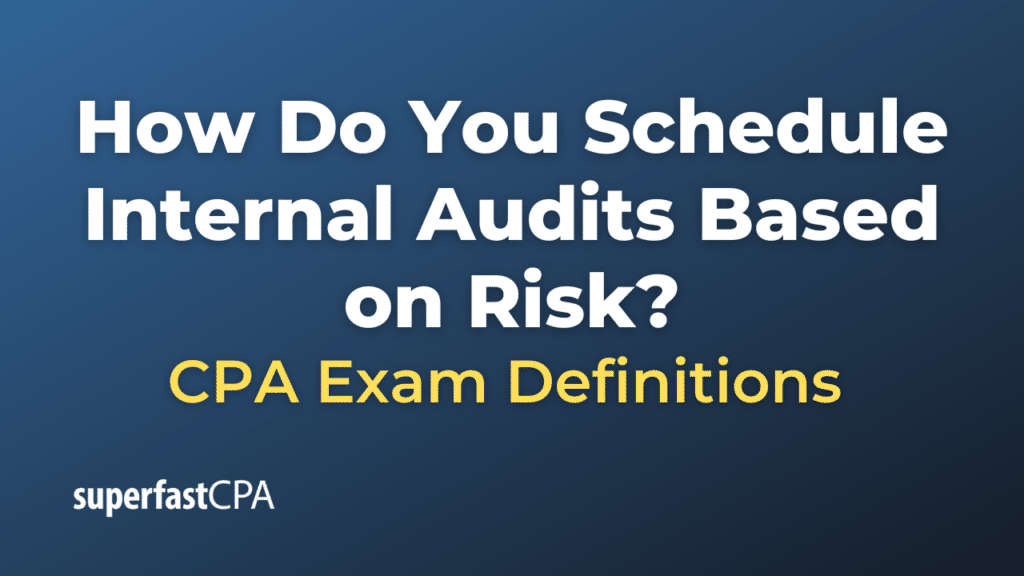Schedule Internal Audits Based on Risk
Scheduling internal audits based on risk ensures that the organization’s resources are effectively and efficiently focused on areas that have the greatest potential impact on the organization’s objectives. Here’s a step-by-step approach on how to schedule internal audits based on risk:
- Risk Assessment:
- Begin by identifying all the potential auditable entities or processes within the organization.
- For each entity or process, assess the inherent risk associated with it. This might be based on factors like financial magnitude, complexity, historical issues, regulatory impact, etc.
- Also assess the control environment: Are there controls in place? How effective are they?
- Risk Ranking:
- Rank auditable entities or processes based on the risk assessment. This can be done using a scoring system or categorizing them into high, medium, and low-risk groups.
- Determine Audit Frequency:
- High-risk areas: Might require annual or even more frequent audits.
- Medium-risk areas: Might be audited on a biennial basis.
- Low-risk areas: Could be audited every three years or might be included in a rotational audit schedule.
- Allocate Resources:
- Based on the risk ranking and the determined frequency, allocate your internal audit resources (e.g., audit personnel, time, and tools) accordingly. High-risk areas might require more experienced auditors or specialized tools.
- Draft the Audit Schedule:
- Prepare an audit calendar for the upcoming year(s). Make sure to spread out the audits in a manner that makes logistical sense and aligns with the organization’s operational calendar (e.g., avoiding year-end closing periods).
- Flexibility:
- While risk-based scheduling provides a structured approach, it’s important to retain some flexibility. New risks can emerge, and priorities can shift, so the audit schedule should be revisited and adjusted if necessary.
- Feedback Loop:
- After each audit, gather feedback. Were the risk assessments accurate? Were there areas of higher risk than initially assessed? This feedback can refine the risk assessment process for future scheduling.
- Stakeholder Communication:
- Keep stakeholders informed about the audit schedule and any changes to it. This includes management and those responsible for the areas being audited. Their input can also be valuable in assessing risk.
- Document Everything:
- Maintain clear documentation of the risk assessment process, justifications for the determined audit frequency, and any deviations from the schedule. This transparency helps in building trust with stakeholders and provides a basis for future assessments.
- Regularly Review and Update:
- The risk environment is dynamic. Regularly review and update the risk assessments, at least annually, or when significant changes occur in the organization.
By scheduling internal audits based on risk, an organization ensures that its internal audit activities are aligned with its objectives and that high-risk areas receive the attention they require. This approach also enhances the value of the internal audit function by focusing on areas where it can have the most significant impact.
Example of How to Schedule Internal Audits Based on Risk
Let’s consider a hypothetical example of a manufacturing company that wants to schedule its internal audits based on risk.
Company Profile:
- XYZ Manufacturing Ltd. produces electronic devices.
- The company has operations in production, procurement, sales, finance, and human resources.
Step 1: Risk Assessment
- Production: Due to the complexity of the production process, the introduction of new technology, and a recent increase in product defects, this area is considered high risk.
- Procurement: Given past instances of supplier fraud and increased reliance on a few key suppliers, this is seen as a high-risk area.
- Sales: The sales processes are standardized with no recent issues, so this area is considered medium risk.
- Finance: With significant cash transactions, regulatory requirements, and a past history of discrepancies in financial statements, this is a high-risk area.
- Human Resources (HR): The HR processes are stable and without major issues in the recent past. This area is seen as low risk.
Step 2: Risk Ranking
- High-risk: Production, Procurement, Finance
- Medium-risk: Sales
- Low-risk: HR
Step 3: Determine Audit Frequency
- High-risk areas: Audited annually.
- Medium-risk areas: Audited biennially.
- Low-risk areas: Audited every three years.
Step 4: Allocate Resources
- Experienced auditors with specialized knowledge in production and finance are allocated to audit those areas due to their complexity and high risk.
Step 5: Draft the Audit Schedule
- 2023: Production, Procurement, Finance, HR
- 2024: Production, Procurement, Finance, Sales
- 2025: Production, Procurement, Finance
Step 6: Flexibility
- The company decides to keep a small portion of the audit team available for emerging risks or ad-hoc audits.
Step 7: Feedback Loop
- After the 2023 audits, feedback indicates that procurement controls have improved significantly, potentially moving it to a medium-risk category in the future.
Step 8: Stakeholder Communication
- The schedule is shared with department heads, and their feedback is incorporated, which helps in fine-tuning the schedule and ensuring smooth audit operations.
Step 9: Document Everything
- Documentation is maintained, showing risk rankings, reasons for the rankings, and the decided audit frequencies. This transparency aids in building trust and provides justification for the audit approach.
Step 10: Regularly Review and Update
- In 2024, due to a market crash, the finance department undertakes several complex financial maneuvers. The risk profile for the finance department is re-evaluated to determine if additional audit focus or frequency is required.
This example showcases how a manufacturing company can systematically approach its internal audits by aligning them with risk. By doing so, XYZ Manufacturing Ltd. ensures that areas posing the highest risks to its operations and objectives are adequately reviewed and controlled.













